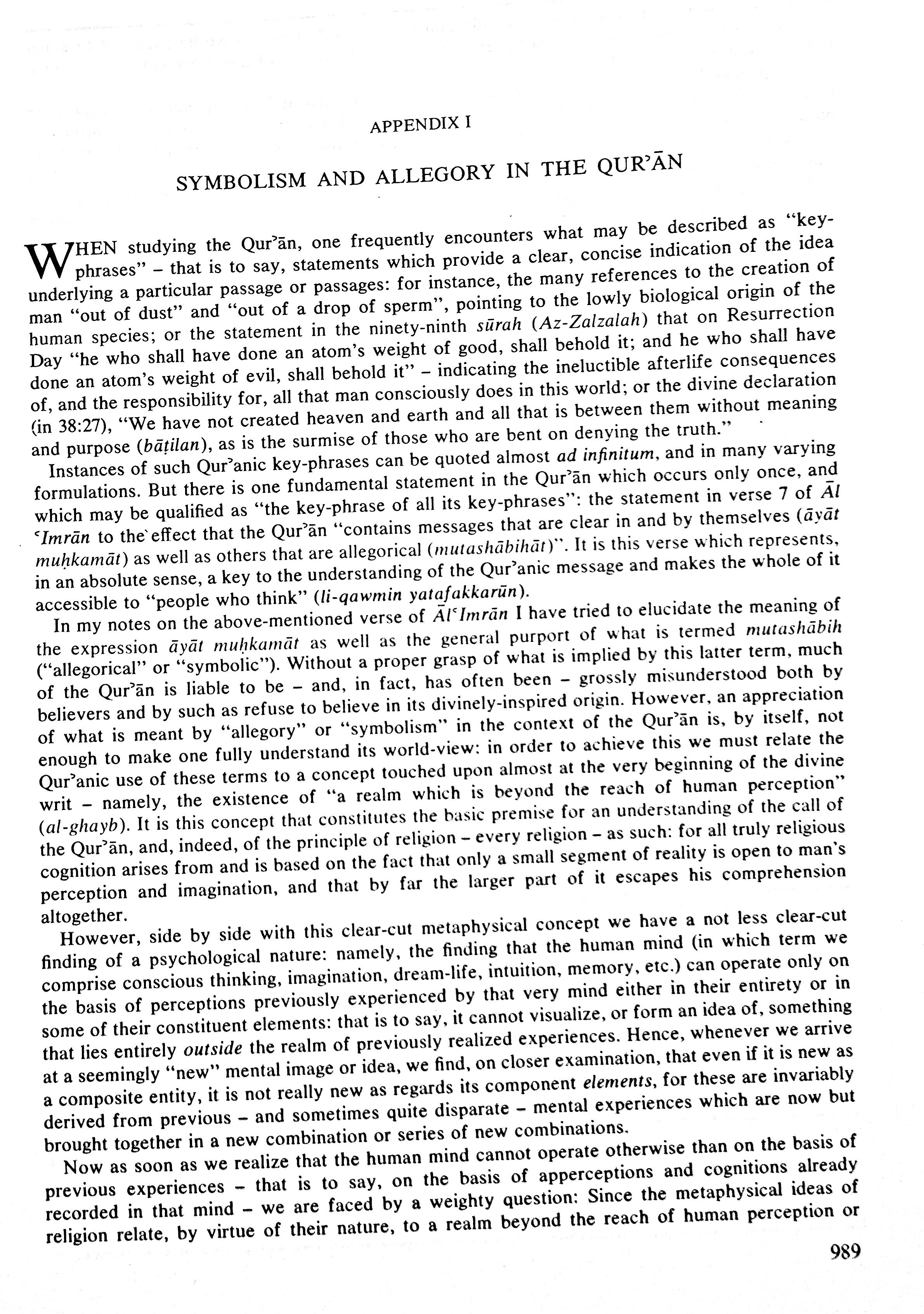Muhammad Asad, The Message of the Qur’ān; Translated and Explained by Muhammad Asad (1980)
Appendix I
Symbolism and Allegory in the Qurʾān
When studying the Qurʾān, one frequently encounters what may be described as “key-phrases” – that is to say, statements which provide a clear, concise indication of the idea underlying a particular passage or passages: for instance, the many references to the creation of man “out of dust” and “out of a drop of sperm”, pointing to the lowly biological origin of the human species; or the statement in the ninety-ninth sūrah (Az-Zalzalah) that on Resurrection Day “he who shall have done an atom’s weight of good, shall behold it; and he who shall have done an atom’s weight of evil, shall behold it” – indicating the ineluctible afterlife consequences of, and the responsibility for, all that man consciously does in this world; or the divine declaration (in 38:27), “We have not created heaven and earth and all that is between them without meaning and purpose (bāṭilan), as is the surmise of those who are bent on denying the truth.”
Instances of such Qurʾanic key-phrases can be quoted almost ad infinitum, and in many varying formulations. But there is one fundamental statement in the Qurʾān which occurs only once, and which may be qualified as “the key-phrase of all its key-phrases”: the statement in verse 7 of Āl ʿImrān to the effect that the Qurʾān “contains messages that are clear in and by themselves (āyāt muḥkamāt) as well as others that are allegorical (mutashābihāt)”. It is this verse which represents, in an absolute sense, a key to the understanding of the Qurʾanic message and makes the whole of it accessible to “people who think” (li-qawmin yatafakkarūn).
In my notes on the above-mentioned verse of Āl ʿImrān I have tried to elucidate the meaning of the expression āyāt muḥkamāt as well as the general purport of what is termed mutashābih (“allegorical” or “symbolic”). Without a proper grasp of what is implied by this latter term, much of the Qurʾān is liable to be – and, in fact, has often been – grossly misunderstood both by believers and by such as refuse to believe in its divinely-inspired origin. However, an appreciation of what is meant by “allegory” or “symbolism” in the context of the Qurʾān is, by itself, not enough to make one fully understand its world-view: in order to achieve this we must relate the Qurʾanic use of these terms to a concept touched upon almost at the very beginning of the divine writ – namely, the existence of “a realm which is beyond the reach of human perception” (al-ghayb). It is this concept that constitutes the basic premise for an understanding of the call of the Qurʾān, and, indeed, of the principle of religion – every religion – as such: for all truly religious cognition arises from and is based on the fact that only a small segment of reality is open to man’s perception and imagination, and that by far the larger part of it escapes his comprehension altogether.
However, side by side with this clear-cut metaphysical concept we have a not less clear-cut finding of a psychological nature: namely, the finding that the human mind (in which term we comprise conscious thinking, imagination, dream-life, intuition, memory, etc.) can operate only on the basis of perceptions previously experienced by that very mind either in their entirety or in some of their constituent elements: that is to say, it cannot visualize, or form an idea of, something that lies entirely outside the realm of previously realized experiences. Hence, whenever we arrive at a seemingly “new” mental image or idea, we find, on closer examination, that even if it is new as a composite entity, it is not really new as regards its component elements, for these are invariably derived from previous – and sometimes quite disparate – mental experiences which are now but brought together in a new combination or series of new combinations.
Now as soon as we realize that the human mind cannot operate otherwise than on the basis of previous experiences – that is to say, on the basis of apperceptions and cognitions already recorded in that mind – we are faced by a weighty question: Since the metaphysical ideas of religion relate, by virtue of their nature, to a realm beyond the reach of human perception or
